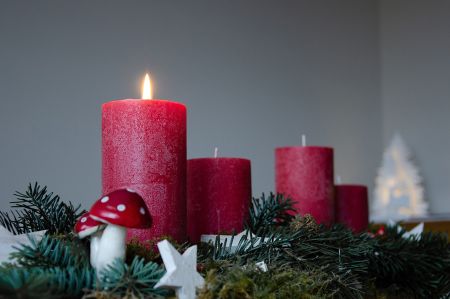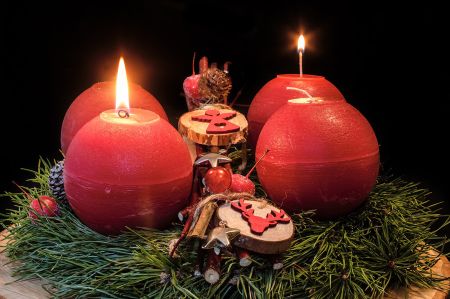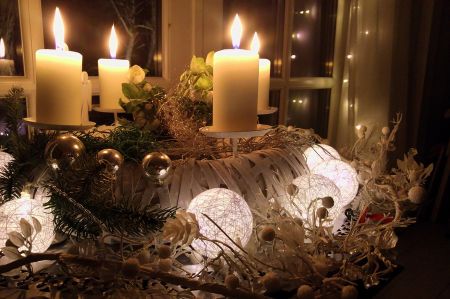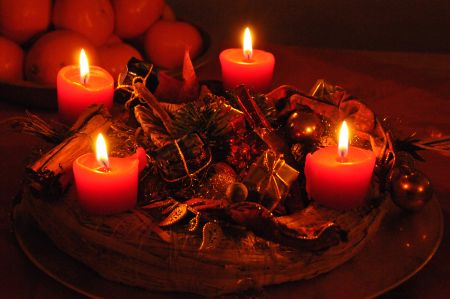Advent wreath - decorative table element or religious symbol
- Written by Portal Editor
In almost all houses and apartments in Europe, the residents enjoy the Advent wreaths, which can be admired as a decorative table element or hanging in the apartment entrances during the pre-Christmas period.
Consisting mainly of plaited fir branches and equipped with four, often red candles, often also with red ribbons, the candles are lit one after the other from the first Sunday in Advent. This is the usual ritual that is simply part of the Advent season for many families. The question remains as to which ideas the Advent wreath actually came from. Reason enough to do some research on the internet.
Theologian and educator Johann Hinrich Wichern
 According to a legend from Hamburg, the Evangelical-Lutheran theologian and educator Johann Hinrich Wichern (1808-1881) is said to have taken care of some children living in poverty. To improve the care and supervision of the children, Wichern moved into an old farmhouse with them, which was called the "Rough House". As is usual in all families at Christmas time, the children in the Wichern house were also very impatient as to when Christmas and the presents would finally come.
According to a legend from Hamburg, the Evangelical-Lutheran theologian and educator Johann Hinrich Wichern (1808-1881) is said to have taken care of some children living in poverty. To improve the care and supervision of the children, Wichern moved into an old farmhouse with them, which was called the "Rough House". As is usual in all families at Christmas time, the children in the Wichern house were also very impatient as to when Christmas and the presents would finally come.
This is how the theologian and educator Wichern came up with the idea of building a time planning tool for the children. He took an old wagon wheel that consisted only of a wooden wreath and spokes and attached 20 red candles and four white candles to the wooden wreath. Aptly enough, Wichern lit the first candle at the beginning of Advent and then let another candle follow each day. Now it was no longer a problem for the children to simply count the days left until the presents were given.
Even today, an Advent wreath, following the example of Wichern, hangs in the church room of the Sankt Michaelis Church in Hamburg as well as in the still existing "Rauhes Haus".
The Advent wreath with four red candles
 This story is considered to be the origin of the social introduction of the Advent wreath in 1839 in the predominantly Protestant part of the population of northern Germany. The Advent wreath slowly spread across the country, but it was not until the middle of the following century that it was also found in predominantly Catholic areas.
This story is considered to be the origin of the social introduction of the Advent wreath in 1839 in the predominantly Protestant part of the population of northern Germany. The Advent wreath slowly spread across the country, but it was not until the middle of the following century that it was also found in predominantly Catholic areas.
At the same time, the Advent wreath was created with only four candles, one candle for each Sunday in Advent. The number of candles in the traditional wreath of Wichern always varied according to the number of days before Christmas Eve, a minimum of 18 red candles if Christmas Eve coincided with the fourth Sunday in Advent, up to a maximum of 24 red candles if Christmas Eve coincided with one Saturday falls.
In addition, there were always four white candles for the Sundays in Advent. Around 1860, the Advent wreath began to be made from fir green. An Advent wreath was hung in a Catholic church in Cologne for the first time in 1925, followed by an Advent wreath in Munich five years later.
 However, there is a poem by Hermann Claudius (1878 – 1980) that describes an Advent wreath. This poem was initially always attributed to the grandfather Matthias Claudius (1740 - 1815), which would have meant that Wichern's Advent wreath could not have been the origin of the idea. Today, based on other writings, we know exactly who the author was, it was Hermann Claudius.
However, there is a poem by Hermann Claudius (1878 – 1980) that describes an Advent wreath. This poem was initially always attributed to the grandfather Matthias Claudius (1740 - 1815), which would have meant that Wichern's Advent wreath could not have been the origin of the idea. Today, based on other writings, we know exactly who the author was, it was Hermann Claudius.
However, since the advent wreath has conquered living rooms across the board, attempts have also been made to interpret a certain symbolism into the wreath. However, our research could not find any reliable sources. Some ecclesiastical interpretations attempt this, which is best attempted with an increase in the light (one candle more each time) as an expression of increasing joy and expectation of the birth of Jesus Christ as the "light of the world". There are similar attempts at interpretation, due to the circular shape of the wreath, due to the colours used for the candles and bows, and also because of the fir green used. The circular shape is intended to refer to the symbolism of the eternity of life given with the resurrection, just as green is the colour of hope and life. The circular shape also symbolizes the relation to the globe and the four cardinal points associated with it.
Purple instead of red - the color of Catholics
 In the Catholic Church and also in some predominantly Catholic regions, you will sometimes find Advent wreaths with three purple and one pink candle.
In the Catholic Church and also in some predominantly Catholic regions, you will sometimes find Advent wreaths with three purple and one pink candle.
The pink candle is then lit on these wreaths on the third Sunday in Advent, which has a special meaning in the Catholic Church.
This Sunday, which can be translated as "Gaudete" from the Latin for "Rejoice", should be particularly emphasized with the pink candle.
The colour symbolism of the candles used on the Advent wreath is often related to the liturgical colours of the paraments.
The typical colour of Advent is basically violet. In the Catholic Church there is also a rite for the blessing of the Advent wreath from the Benedictional.
 In the Catholic part of Ireland, the otherwise similarly designed Advent wreaths are even decorated with five candles.
In the Catholic part of Ireland, the otherwise similarly designed Advent wreaths are even decorated with five candles.
Similar to Germany, three violet candles are used to mark the Advent season on the first, second and fourth Sunday of Advent, the fourth candle in pink on Sunday Gaudete (third Sunday in Advent) and a white candle as the fifth candle for Christmas Eve.
In predominantly Protestant Norway, the traditional colours of all four candles are purple, while in Sweden the candle on the first Sunday of Advent is white. All others are purple. So far, we do not know why red candles are predominantly used in Germany.
 There is also the custom of using four different coloured candles in purple, red, pink and white. This is often done using the names of the respective Sundays in Advent, which come from the liturgy, so the candles are then called St. Isaiah's candle, St. John's candle, St. Mary's candle, etc. The candles should also always be lit next to each other, not opposite, according to tradition. Advent candles on the wreath should always be lit counter clockwise. Despite many inquiries, we could not get the "why" answered.
There is also the custom of using four different coloured candles in purple, red, pink and white. This is often done using the names of the respective Sundays in Advent, which come from the liturgy, so the candles are then called St. Isaiah's candle, St. John's candle, St. Mary's candle, etc. The candles should also always be lit next to each other, not opposite, according to tradition. Advent candles on the wreath should always be lit counter clockwise. Despite many inquiries, we could not get the "why" answered.
Our impression is that it is a beautiful custom that radiates festivity and tranquillity, contemplation and warmth. Let's always look forward to the diversity of the Advent wreaths, most of which are creatively handcrafted by the family, during the otherwise predominantly grey season.
Please read as well:
